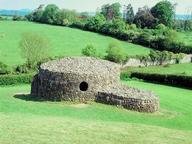In the northern kingdom of
, warriors of the Red Branch Knights gathered in
, the legendary capital of the kingdom, to feast with King
. Among the guests invited to the house of the smith
was a boy named
, son of
, the king's sister.
The boy arrived alone, unaware that the smith's ferocious hound had been set loose to guard the grounds. When the beast attacked him, he defended himself and killed it by driving a
down its throat with his hurley. Ashamed to have killed the hound, the boy offered to make amends: he would serve as a guard in its place. So he was given a new name -
, meaning "the hound of Culann".
Years after this fateful encounter with the hound, the boy sought the guidance of the renowned warrior-woman
, who ruled the Isle of Skye. Under her fierce tutelage, he mastered the deadly art of combat and learned to wield the terrible
, a barbed spear that tore through enemies and could only be withdrawn by cutting outwards.
In battle, he was overcome by the
, a frenzied distortion that transformed his body and mind into something monstrous. No enemy could stand up to him during this attack. Our hero was also known for his friendship with
, which later turned to enmity during the
("The Cattle Raid of Cooley"). He was forced to kill his former friend with the spear
.
His own death was foretold by the prophecy of
, the goddess of war and fate. In battle he was surrounded and mortally wounded by a large group of enemies led by
, the son of Cú Roí. Despite his injuries, he tied himself to a standing stone, using his intestines to hold himself upright. This allowed him to die standing up, which was significant in Irish warrior culture as it demonstrated his indomitable will and defiance even in death.
